TASK 1: WHAT’S IN YOUR BAG?
Monday, May 23, 2022
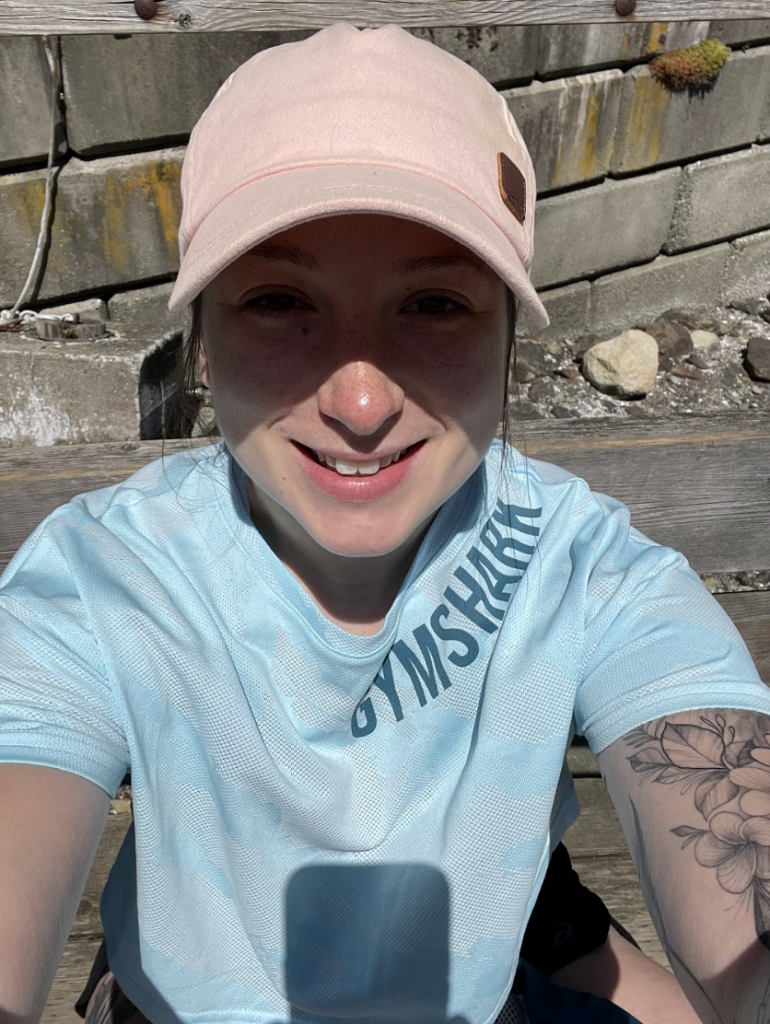
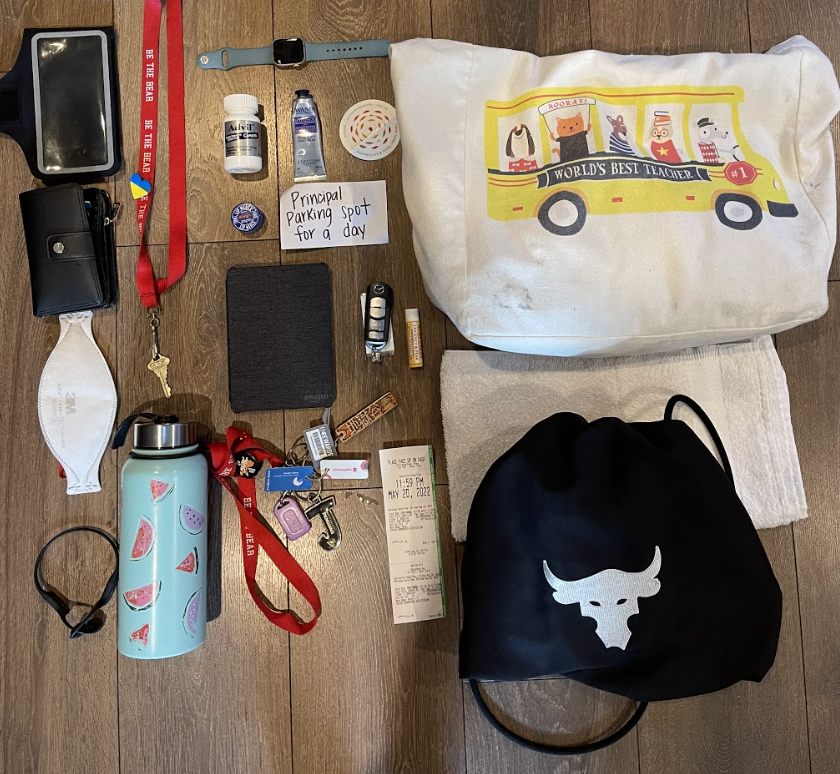
Hello MET Community & ETEC 540 Peers,
My name is Junel Lapinskie. For the purpose of this task I have included a picture of myself and an array of items that I commonly carry in my bag(s). Thinking about why I choose to transport the items you see above, I will be providing you with a reflection.
Mostly everyday, I carry a bag in a bag. This might seem strange, but for my daily schedule it just makes the most sense. I am an active person who enjoys going for a run and working out in North Vancouver right after teaching at Caulfeild Elementary for a day in West Vancouver. So, I always carry my three year-old black Under Armour Project Rock bag inside my trusty and large “World’s Best Teacher” bag.
Within my gym bag, I carry with me: a large watermelon water bottle to keep hydrated (one of my first students’ thoughtfully gifted to me); my gym keys that has my key fob to Anytime Fitness in North Vancouver; my Aftershokz headphones to motivate me and keep me out of my head for a bit (they are the only ones that stay on my head when I exercise); my waterproof active band for my phone so I can keep running on even the rainiest of days; a quality white Fairmont sweat towel (I received when I worked at the Fairmont Jasper Park Lodge); and my Apple Watch to keep the time and track my exercise progress.
In my teacher bag, I have: a N95 mask just in case I feel uncomfortable, so I can be respectful to anyone who asks me to wear it, or if I feel unwell unexpectedly; my purse which holds my driver’s license and Starbucks gift cards, so I can drive in between North and West Vancouver and pick up a chai tea latte on the way; my Mazda car keys; my school keys that I wear everyday (it has a Ukraine heart pin that I received because I am running to raise money and stand up for Ukraine); lavender lotion, Blistex and Burt’s Bee lip balm to take care of myself; Advil for the crazy teaching days when I am too busy to drink water and end up with the wildest of headaches; my Kindle to read when I have some downtime; a parking receipt for Horseshoe Bay parking at the ferry that I forgot to throw out (keep it as a reminder of my happiest days this year when I was kayaking on Bowen Island with my colleagues); a coupon for winning Principal’s parking spot for a day to remind me of my accomplishments; and finally a sticker I received from Liquid Amber Tattoo for my latest addition to my full sleeve (a lion).

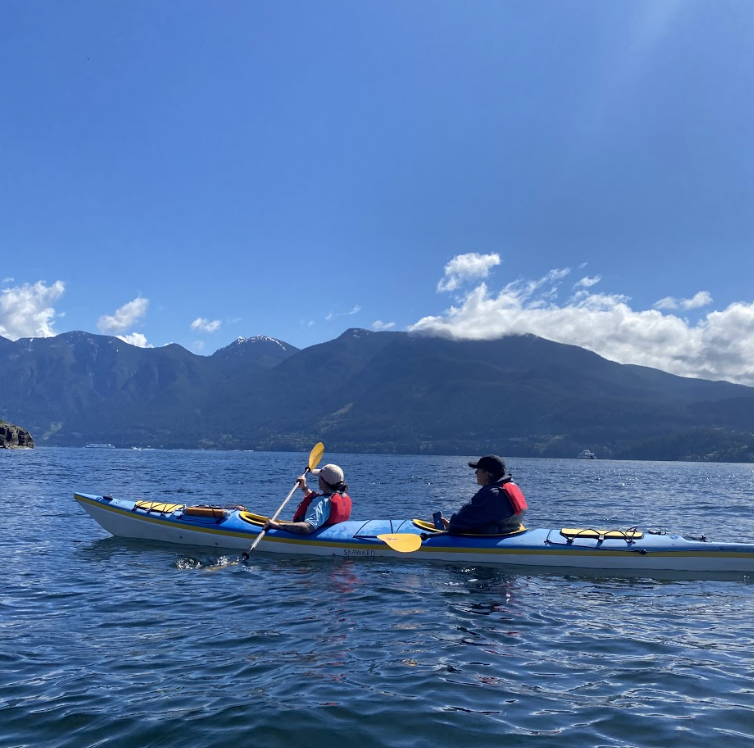
The items in my bag(s) can be considered texts because a text is considered to be technology, a creation or something that is of oral or written construct. These items speak to my fitness nature, my commitment to self-care and the satisfaction I have from my teaching career. The belongings I have shared also communicate my categorized life that separates my work and personal life so I can dedicate myself to them fully. I am passionate about representing my work place, which is why I have the school lanyard for my Anytime Fitness key fob. I engage in the school culture and take up activities that bring happiness to my life. In this way, my bag(s) illustrate that I have the following literacies: digital, physical/health, financial, and social literacy.
Thinking about text technologies that are in my bag, these include the following that say the most about how I engage with language and communication:
1) Kindle – I am able to alter the way the text looks by changing the size of the writing, the style of font and change its appearance to dark mode. I love to learn and enjoy the fact that I can look up unknown words by clicking on them.
2) Apple Watch – While a functional tool that tracks my fitness, allows me to answer or decline calls, and check the weather, the screen can be too small, which makes it harder to concentrate on the device. I appreciate that it will read out to me my running time or a text.
Taking these bags back in time…they would have never existed, especially if this were 15-25 years ago. The bag would have been a small purse with: a passport, cellphone, cash and ID. During those years, I lived and travelled overseas. I was attending grade school and high school in Indonesia, Angola, Kazakhstan, China and Poland. I did not need much and had much less responsibilities.
I can imagine that an archeologist from the future viewing the contents of my bag would come to the conclusion that the bag came from the period of the COVID-19 pandemic. Much of the items in the bag point to someone who is trying to take care of their mental health during a traumatic historical event.
TASK 2: DOES LANGUAGE SHAPE THE WAY WE THINK?
Saturday, May 28, 2022
Puzzle Question!
Look at the below photo of number words from an unknown language. Understand how the number words are connected to a numerical value in the “given” column. Looking at the “figure out” column, solve which number words are connected to the correct numerical value. How did you arrive to your conclusion? I have been working away at this for a bit. I would love if anyone could enlighten me on how to solve this.
My first attempt was using math, as I remember in the French language, to say 17 (“dix-sept”), you need to say the word ten (“dix”) first and then add the word seven (“sept”).

TASK 3: VOICE TO TEXT
Saturday, June 4, 2022

How does the text deviate from conventions of written English?
The text deviate’s from conventions of written English as it does not follow any grammar rules or autocorrect for capitals. For instance the lack of capitals and punctuation is evident when the speech-to-text tool wrote “so I went over to him and we kind of played and he calmed down he cuddled with me we watched Netflix together but I was just thinking like he had all day to eat that steak but he just chose when I got home to eat it which did not make sense”. As the speech tool did not include punctuation, there are no pauses in the passage that indicates a thought is complete. Neither does it separate events. This also resulted in no capitals to the start of a sentence.
What is “wrong” in the text? What is “right”?
There are some things that are wrong in the text. In the beginning of my oral storytelling, I said “period” when I wanted there to be correct punctuation. However, I quickly stopped this, since I lost track of the story and became confused. This explains the run on sentences and makes the story difficult to read. Even so, the OneNote dictation tool recorded every word I said and did not miss one. Considering the individual words in the text, the tool was able to spell everything correctly. I was also surprised when the dictation tool capitalized and spelled Loki’s name and the Netflix brand correctly. Despite there being no punctuation for the end of sentences, the text does include apostrophes for contractions such as, “can’t” and “it’s”.
What are the most common “mistakes” in the text and why do you consider them “mistakes”?
Understanding the things that went wrong in the storytelling text: punctuation, grammar and capitalization were also the most common mistakes. I consider these to be mistakes because “reading and writing do not come so naturally and must be taught.” (Gnanadeskian, 2009, p. 4). This is similar to a Vygotskian notion in which, from socially and culturally engaging in learning how to write, these mistake are not made up, but ingrained from what I absorbed (Haas, 2013).
What if you had “scripted” the story? What difference might that have made?
Ong (2002) states that “writing […] is a particularly pre-emptive and imperialist activity that tends to assimilate other things to itself even without the aid of etymologies” (p. 11). If I had scripted the story, each word I carefully chose would have intonation and emotion giving it meaning. Even if these are non-verbal cues which are not detected by the dictation tool, it is an important experience with storytelling. Additionally, scripting the story would have helped me say things like, “comma” or “period” without losing track of the story’s events.
In what ways does oral storytelling differ from written storytelling?
From this experience, I realize that oral storytelling is very different from written storytelling. More specifically, “writing is generally done more deliberately than speaking, so finished written pieces are much more carefully crafted […] written texts can thus convey their message more precisely, adding to the sense that writing is worth more than speech” (Gnanadeskian, 2009, p. 5). Having my OneNote microphone record an unscripted story did not have the details or heartwarming feeling I had hoped for. If purely written, I could have spent the time exploding the moment on how “Loki’s long whiskers raked the side of the pumpkin causing him to flinch each time from the unknown”.
References
Gnanadesikan, A. E. (2009). The writing revolution: Cuneiform to the internet. John Wiley & Sons. http://dx.doi.org/10.1002/9781444304671
Haas, C. (2013). Writing technology: Studies on the materiality of literacy. Routledge. https://doi-org.ezproxy.library.ubc.ca/10.4324/9780203811238
Ong, W. J. (2002). Orality and literacy: The technologizing of the word. Routledge. https://doi.org/10.4324/9780203426258
TASK 4: MANUAL SCRIPTS & POTATO PRINTING
Saturday, June 11, 2022


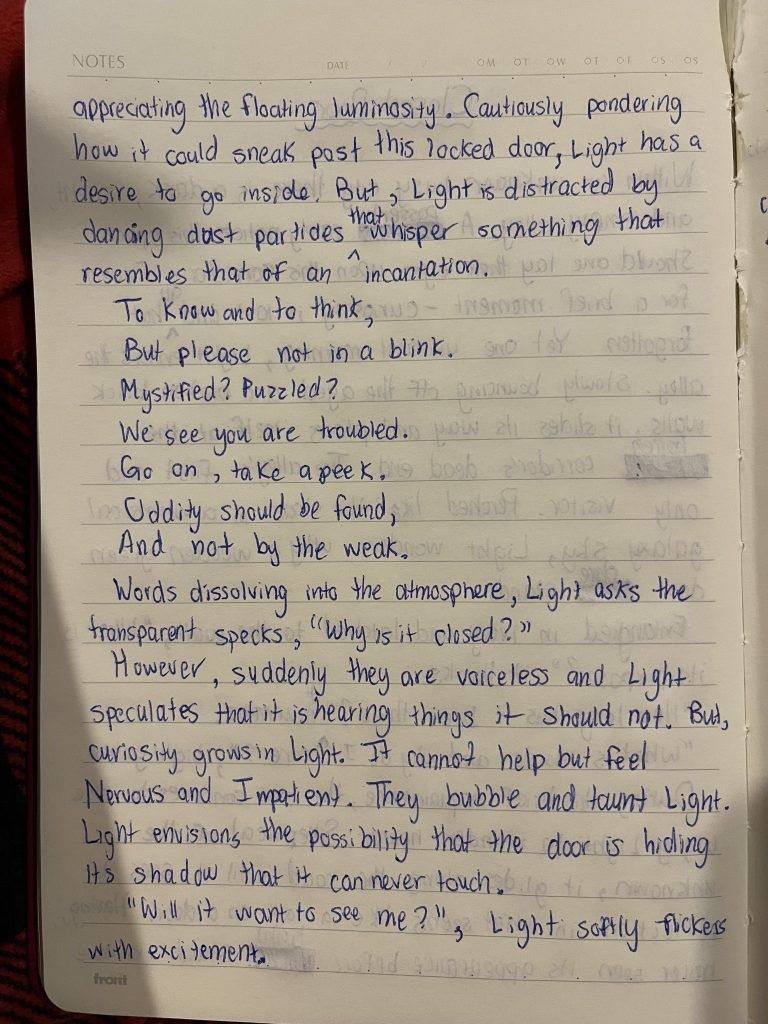
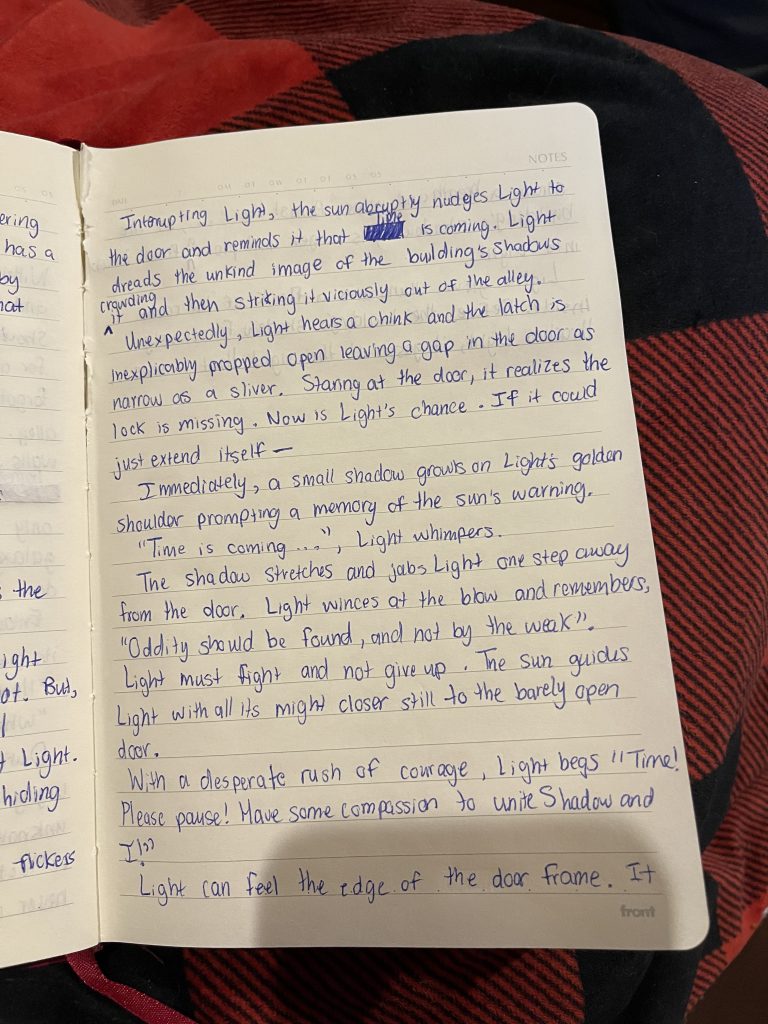



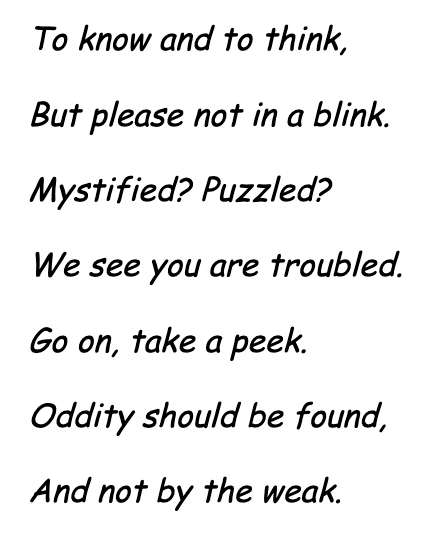


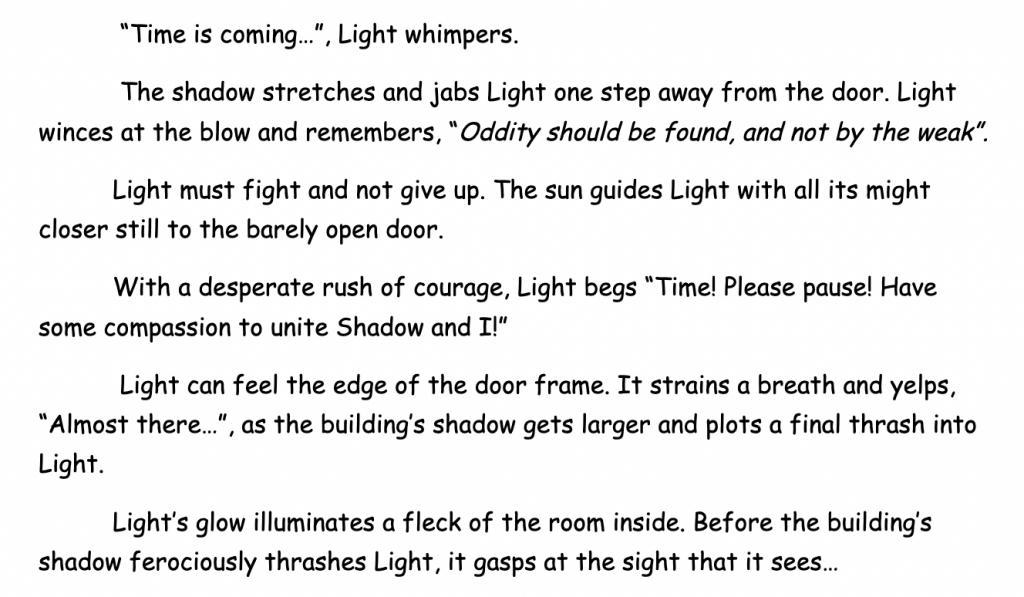
Reflecting on my creative writing piece, it is important to note that I wrote it both in a journal and on a laptop with my keyboard on a Google Doc owing to my curiosity for their differences. Normally, I type because it is the fastest way to transfer my ideas somewhere to be stored. Additionally, it guides me to success. For instance, if I spell a word incorrectly, Google Docs will underline it prompting me to correct it.
Writing by hand proved to be difficult for me. It took more time and I ended up getting lost in the idea of how a word was spelled, as opposed to the ideas I wanted to write down. I learned that I do not have as much of an attention span and patience when writing manually. Typing seems to be based on my muscle memory and comes more naturally.
When I made a mistake or wanted to change my writing, I included symbols. To input words in places where they were accidentally omitted, I drew a triangle symbol under a line. When I misspelled a word, I boxed it and wrote the correct spelling on top. In hindsight, I should have used a pencil instead of a pen to write with. Pens are permanent and should have been used for a good copy version. It would have made more sense to use a pencil to write the draft since a pencil’s graphite affords the ability of erasure on journal paper better than pen ink.
I have indicated my preference of typing on a keyboard’s laptop as a mechanized form of writing. This experience has affirmed there is a significant difference between writing by hand and using mechanized forms of writing. Pens require handcrafting the output of writing slowly. Using my keyboard demonstrated how fast paced the production of writing can be when utilizing a machine. More importantly, mechanized forms of writing make it clear how much more moveable and editable it is than writing by hand.
TASK 6: AN EMOJI STORY
Thursday, June 23, 2022
Title of Movie Recently Watched

Plot of Movie








Reflection of Process
In order to write non-orthographically, I relied on ideas and words to communicate the title of the movie I watched, as well as its plot. Translating the title and plot with emojis was more challenging than previously thought due to how “signs in picture writing, stylized images, seem to constitute their own silent language” (Bolter, 2001, p. 59). For instance, navigating through all the emojis to find the right symbol that matched my interpretation and personal analysis was a battle owing to how I wanted to ensure my audience would make the same meaning. Not being able to write my summary of the plot under its respectful emojis was difficult since my initial goal was to avoid symbols being arbitrary. However, after some time and getting used to clicking my chosen emojis, I discovered that “[m]ultimedia applications are in fact often characterized by their “buttoned style.” […] and this ongoing chain of visual and aural effects takes the place of discursive prose” (Bolter, 2001, p. 72).
When beginning this exercise, I started by translating the title. Navigating and exploring emojis took me more time to consider what to leave out or add in my visual language. Thus, the title was a good initiation into transforming the “[a]ptness of mode” (Kress, 2005, p. 19) that I am not normally comfortable utilizing. Additionally, I chose the film to write non-orthographically to owing to how easy it was to visualize. More specifically, I was able to find various emojis that related to words or meanings that I aimed to communicate to my audience. Presently, emojis afford for more details and diversity in their images. Additionally, “[i]n spatially organized representation, the elements that are chosen for representation are simultaneously present, and it is their spatial arrangement that is used to make (one kind of) meaning” (Kress, 2005, p. 13). In my experience, the variety of animals, the option to choose skin colour and availability of place and object emojis helped to transfer the words and ideas in my head onto this blog space in order to depict a movie.
After completing this task, I now have better appreciation for why students jump at opportunities to include emojis or other visuals, such as gifs, into their written digital work (e.g., Book Creator). It’s a way for them to make a connection to an emotion or their “sequential logic of speech” (Kress, 2005, p. 14).
References
Bolter, J. D. (2001). Writing space: Computers, hypertext, and the remediation of print (2nd ed.). Lawrence Erlbaum Associates, Inc.,. https://doi.org/10.4324/9781410600110
Kress, G. (2005). Gains and losses: New forms of texts, knowledge, and learning. Computers and Composition, 22(1), 5-22. https://doi.org/10.1016/j.compcom.2004.12.004
TASK 7: MODE-BENDING
Saturday, July 2, 2022
Reflection of Process
The New London Group (1996) had a large influence on my redesigning of this activity. As they discuss the importance of multimodality and/or multiliteracies, they also highlight a key element which is that “experimenting with multiliteracies as a notion […] might supplement and support literacy curriculum” (The New London Group, 1996, p. 89). The primary way I originally approached the task seven weeks ago was text-based, and followed that of a linguistic and visual approach. Reflecting on how to transform the semiotic mode of the first task, and after careful consideration of this week’s readings, my goal was to engage in mode-changing. That is, I took the written information I created from the first task and redesigned it technologically and with a game-based element as a way to change its meaning. Recreating the task to be an interactive quiz afforded for visual, mental and auditory stimulation for my audience. Accordingly, by “employ[ing] animated image and text accompanied by sound in an effort to produce visually dynamic pieces [… it] challenge[s] conventional literary structures” (Dobson & Willinsky, 2009, p. 8). Instead of my focus being to design text in a linguistic format, my design transformed into one that the center of attention is on entertainment and digital text.
After engaging in mode-changing, I realized how time consuming reconstruction can be owing to how “it is never a reinstantiation of one Available Design or even a simple recombination of Available Designs” (The New London Group, 1996, p. 76). Spending the time and mental energy to problem solve and create a tool that functions purposefully and appropriately was challenging. This was a part of the process that could not be completed in one day, at least for me. Nonetheless, by redesigning the tasks literacy output there is a potential benefit with transforming the text for users. Specifically,
“it is arguable that some of the most innovative text experiments in online publishing –
ones that truly push the boundaries of established conventions of writing, and that work
to explore the particular affordances of digital media – have occurred in creative contexts
where the literacy and design communities converge with a view to generating alternate,
innovative, multimedia forms” (Dobson & Willinsky, 2009, p. 8).
While my redesign of Task 1 is only the beginning of digital exploration and multimodality, I envision that by including further collaboration with my colleagues, this task has the potential of being a hypertext fiction or narrative game world.
References
Dobson, T., & Willinsky, J. (2009). Digital literacy. In D. R. Olson & N. Torrance (Eds.),
The cambridge handbook of literacy (pp. 286-312). Cambridge University
Press. https://doi.org/10.1016/S0740-624X(99)80019-7
The New London Group. (1996). A pedagogy of multiliteracies: Designing social
futures. Harvard Educational Review, 66(1), 60-93.
https://doi.org/10.17763/haer.66.1.17370n67v22j160u
TASK 8: GOLDEN RECORD CURATION ASSIGNMENT
Saturday, July 9, 2022
- Track 6: Mexico, “El Cascabel,” performed by Lorenzo Barcelata and the Mariachi México
- Track 7: “Johnny B. Goode,” written and performed by Chuck Berry
- Track 8: New Guinea, men’s house song, recorded by Robert MacLennan
- Track 9: Japan, shakuhachi, “Tsuru No Sugomori” (“Crane’s Nest,”) performed by Goro Yamaguchi.
- Track 10: Bach, “Gavotte en rondeaux” from the Partita No. 3 in E major for Violin, performed by Arthur Grumiaux
- Track 14: “Melancholy Blues,” performed by Louis Armstrong and his Hot Seven
- Track 16: Stravinsky, Rite of Spring, Sacrificial Dance, Columbia Symphony Orchestra, Igor Stravinsky, conductor
- Track 21: Holborne, Paueans, Galliards, Almains and Other Short Aeirs, “The Fairie Round,” performed by David Munrow and the Early Music Consort of London
- Track 22: Solomon Islands, panpipes, collected by the Solomon Islands Broadcasting Service.
- Track 24: China, ch’in, “Flowing Streams,” performed by Kuan P’ing-hu
Reflection of Justification
In the words of Rumsey in Brown University (2017) I decided to approach this assignment based on, “what can we afford to save” as opposed to “what can we afford to lose”. It is important to note that the parameters or criteria I focused on in order to select the songs was based off of my personal preferences. Were it up to me; however, I would have chosen more songs to be on the Voyager’s Golden Record. Nevertheless, I chose the above ten songs because I wanted the curation of music to be a reflection of the creativity of instruments that capture our global history in music (e.g., Track 14 and 16). Additionally, I tried to focus on this year’s theme of diversity and inclusivity, and felt it important that more than the Western world was highlighted in their talents (e.g., Track 6, 8, 9, 16, 21, 22 & 24). While not all my choices are upbeat and include natural sounds, most of them do include these elements that I think represent how Earth should be remembered.
References
Brown University. (2017, March 23). Abby smith rumsey: “Digital memory: What can we afford to lose?”
[Video]. YouTube. https://www.youtube.com/watch?v=FBrahqg9ZMc&t=2s
TASK 9: NETWORK ASSIGNMENT USING GOLDEN RECORD CURATION QUIZ DATA
Monday, July 18, 2022
Palladio provides numerous opportunities to change the layout of the network visualized based off of participants’ music choices. Owing to this, I will analyze the dimensions and count, as seen in the below screenshot. Additionally, I will share the implications of these outcomes and what they have to say about our generation.

At a first glance, it appears that the multigraph illustrates participants and songs as an individual node/vertex. The lines we see are called edges that represent connections between participants and their music selection. As Systems Innovation (2015) describe, “connectivity is important in graphing paradigm” and these aforementioned elements are key in showing this.
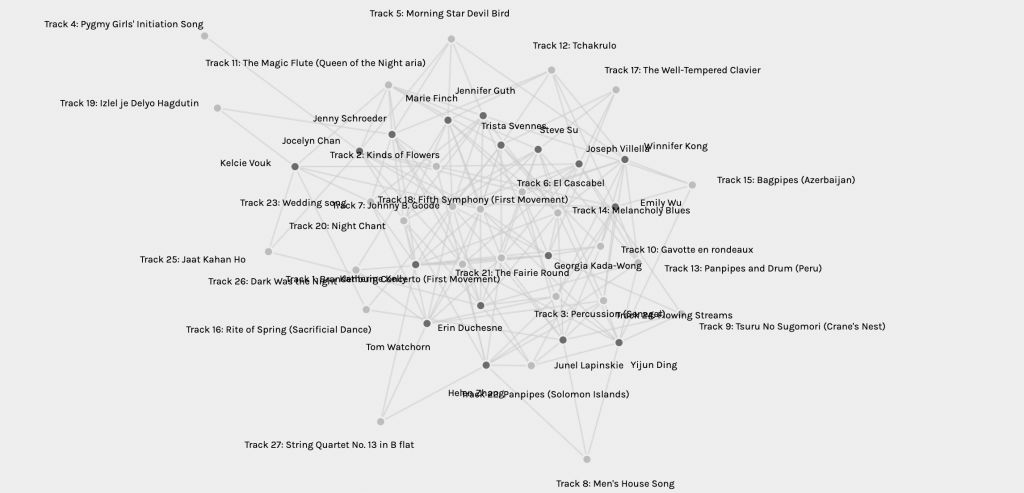
While the graph demonstrates connections between individuals and their music choices, it also gives insight into the strength of these choices as Palladio groups those of us with similar responses into communities. When changing the count by selecting “Sum of Weight (from Edges table)” it appears that those that had the most similar responses are:
- Melancholy Blues (Track 14)
- Fifth Symphony (First Movement) [Track 18]
- Johnny B. Goode [Track 7]
- Brandenburg Concerto (First Movement) [Track 1]
- The Fairie Round (Track 21)

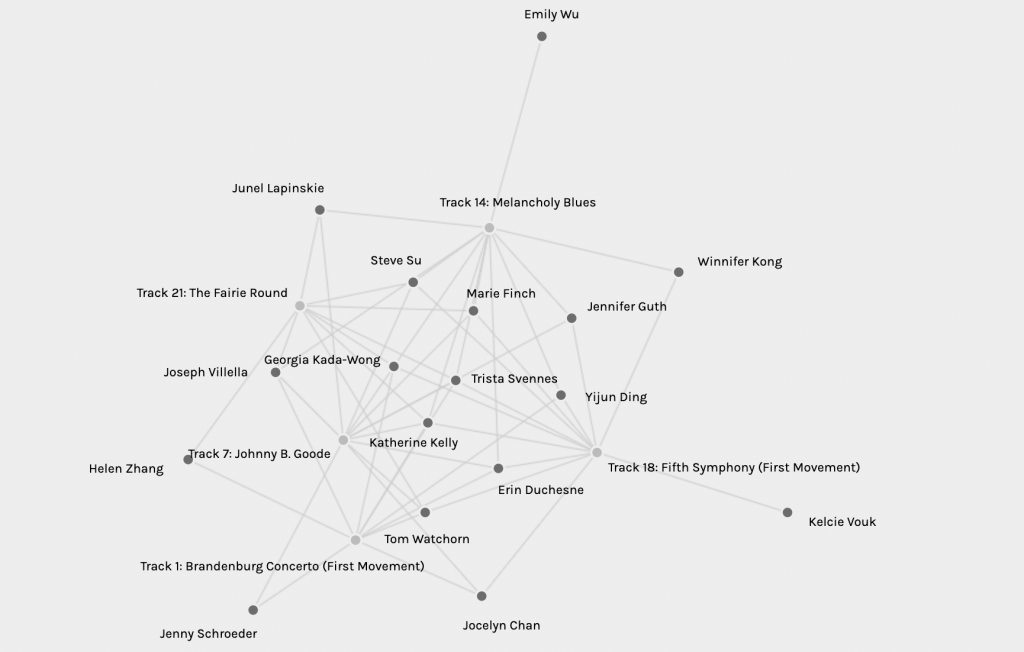
Considering each of the above song’s degree of connectivity with similar responses, it is clear that: Melancholy Blues, Fifth Symphony (First Movement) and Johnny B. Goode are connected to 12 participants; Brandenburg Concerto (First Movement) is connected to 10 participants; and The Fairie Round is connected to nine individuals.
Making sense of why the responses are similar, Mixably (2016) posits that “people who listen to the same music could have similar attributes”. So, although we are a group of colleagues living in different parts of the world working on a Master’s course online, we may be more compatible than we think. Hull (2009) concludes that “preference of more than one genre of music [is] significantly correlated with Openness” (p. 41). That is, to be unconditionally open-minded of diverse experiences. While this is a unique and interesting statement related to the Palladio graphical visualization, the graph still does not capture the true reasons behind our music choices.
For instance, reflecting on why I selected the songs that I did, this was owing to nostalgia and wanting to encompass the diversity of our global history as represented by a group of music. Having not interviewed or asked participants about their reasons, significant qualitative data is missing that may reveal underlying connections that may appear as themes that could be interpreted appropriately. At the same time, the rationalization for not selecting particular songs is not explicitly exhibited. Consequently, the results are left up for anyone’s interpretations and assumptions could be made without recognition of our ages, where we are from, occupation, educational background, etc. If a questionnaire or interview were included, then it may be easier to reflect and interpret the null choices in the data.
References
Hull, R. K. (2009). The relationship between personality and music preference (Publication No. 640) [Doctoral project, Loma Linda University]. Psychology Commons.
Mixably. (2016, June 7). Music and relationships. Medium. https://medium.com/the-world-is-playlisting-the-official-mixably-blog/how-important-is-it-to-have-the-same-taste-in-music-as-your-friends-83bacfbff5ec
Systems Innovation. (2015, April 19). Network connections [Video]. YouTube. https://www.youtube.com/watch?v=2iViaEAytxw&t=79shttps://www.youtube.com/watch?v=2iViaEAytxw&t=79s
TASK 10: ATTENTION ECONOMY
Saturday, July 23, 2022
First of all, I would like to begin by saying that this was the most frustrating, challenging, yet eye-opening experience! Additionally, the above game is one that I was able to reflect on more, since I am also in the midst of completing ETEC 511. That is, the course closely explores usability.
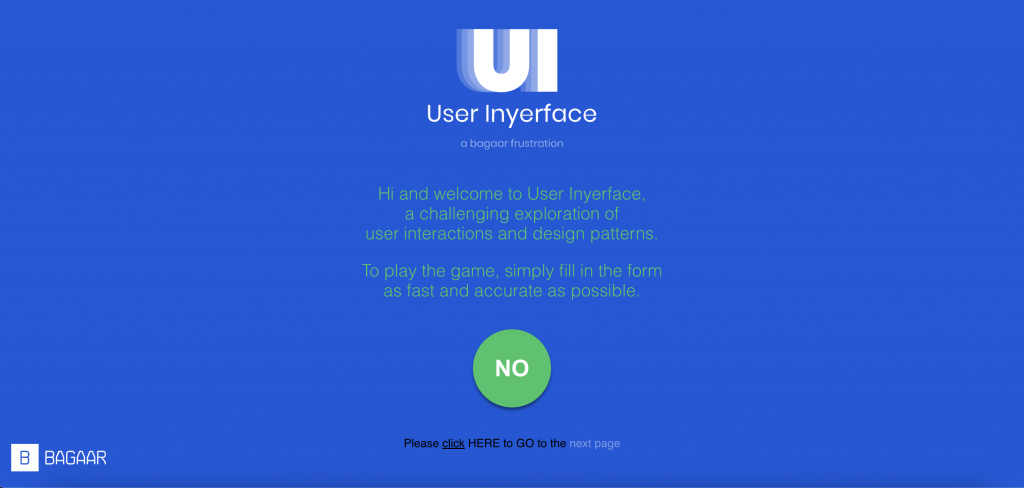
As you can see from the above image, I am already met with a challenge to “simply fill in the form”. “NO”, “next page” and “click” appeared to be unclickable buttons and/or hyperlinks. Out of annoyance, I began clicking everywhere on the page until I finally clicked on “HERE”, which took me to the form. Based off of this initial experience, it is safe to say that the website does not align well with the idea that “various principles need to be followed in order to support usability, making systems easy to learn and easy to use” (Issa & Isaias, 2015, p. 32).
Other examples of this instance are, but are not limited to when: I was filling the form and I could not type the information, but was required to delete the placeholder text first; it was mandatory to move a slider to determine my age and was irritably over-particular; and I struggled to fill out the captcha bot at the end because I had to click all the lights, glasses, bows or checks, but had to scroll down to find all the checkboxes to click them (see below snapshot).
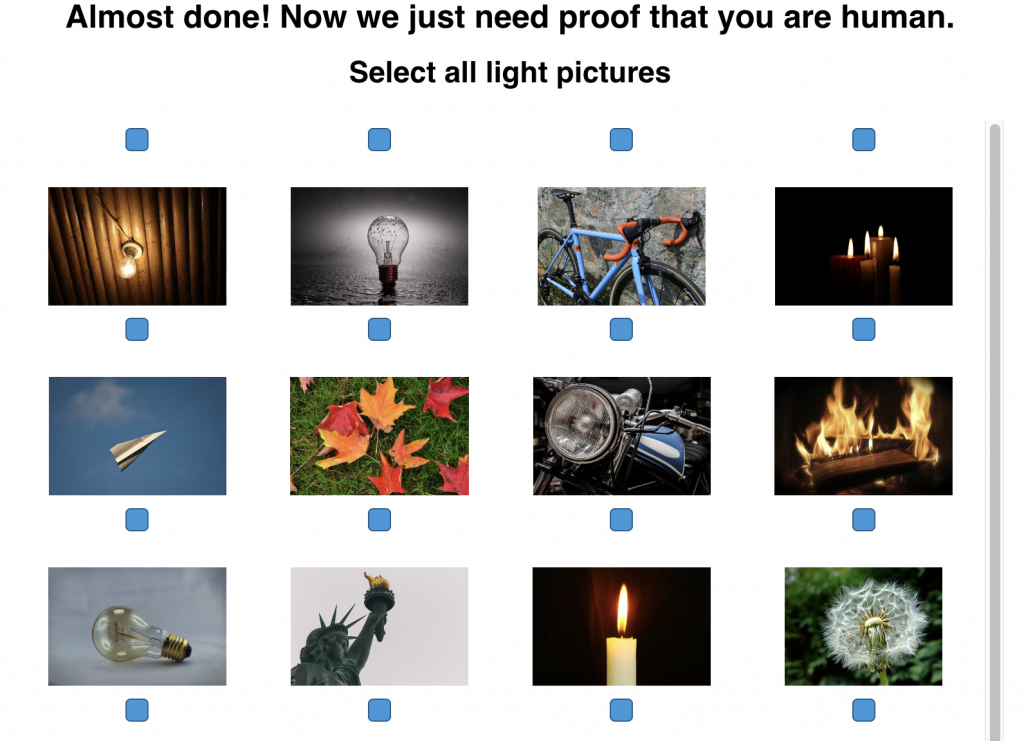
Not only am I made aware of usability issues, the overall messaging from the game reveals what honest interfaces feature as opposed to dark patterns. That is, it cautions its audience to be conscious of “tricks used in websites and apps that make you do things that you didn’t mean to, like buying or signing up for something” (Brignull, 2010). In this way, companies take advantage of us such as Google, Amazon and Reddit. However, this is just the tip of the iceberg. According to Brignull (2010), there are over 400 cases!
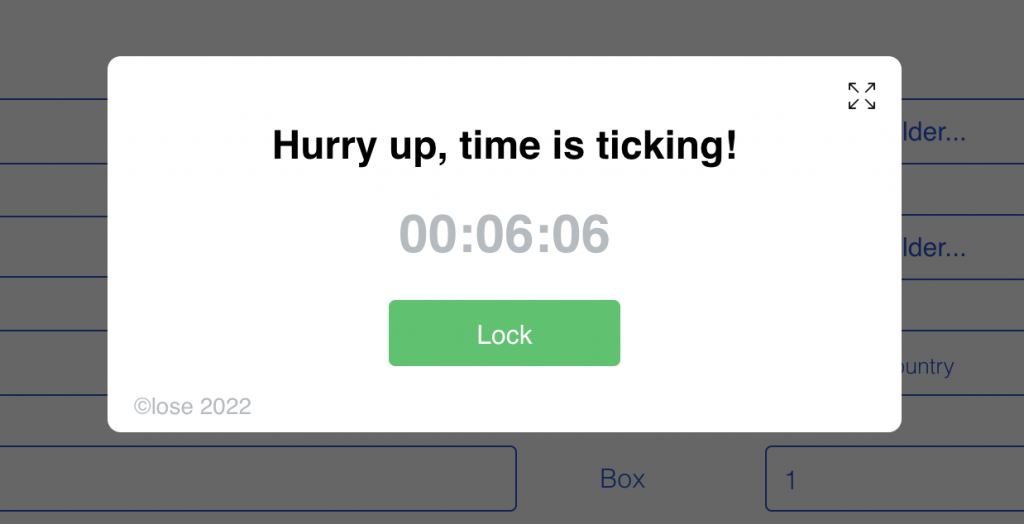
Part way through the game, an irritating popup (see screenshot above) consistently showed up on my screen delaying my ability to complete the form. This is also known as, “misdirection: the design purposefully focuses your attention on one thing in order to distract your attention from another” (Brignull, 2010). In this particular case, I was entirely occupied with how to close the popup, that it took me some time to return to filling in the form. Eventually, I figured out that I needed to select “lose2019” on the bottom left hand side of the box to close it.

Another form of dark patterns ensued when the top of the screen said, “This site uses cookies, it that a problem for you?”. Unfortunately, “YES” was unclickable and I was only given the option to click “Not really, no” to continue (see snapshot of confirmshaming above). This is a form of deceptive design called, “confirmshaming: the act of guilting the user into opting into something. The option to decline is worded in such a way as to shame the user into compliance” (Brignull, 2010). Many news article websites or even academic journal libraries utilize this method in such a way that in order to read such valued and essential content, you must accept cookies. This is unfortunate since accepting cookies can lead to what shows up on your internet search in the future. Cookies can track your payment and login history, which may be one way credit card information is stolen or individual’s accounts are hacked. Technews (2021) confirmed this when they announced that “according to the latest discovery, over 2 billion cookies from popular online services like AliExpress, Amazon, Facebook, Dropbox and YouTube were stolen from unaware users’ machines by custom Trojan malware”. Cookie stealing is a serious issue that the public needs to be made more aware of.

Despite the lack of usability and the mimic of dark patterns displayed, I made it to the end in an abysmal 19:32 minutes. “A true interface legend”? Maybe not. However, reflecting on this experience is what I consider to be my biggest accomplishment, especially since it brought to light how my attention is being manipulated every time I use the internet or an app.
References
Brignull, H. (2010). Deceptive design. Deceptive design. https://www.deceptive.design/
Issa, T., & Isaias, P. (2015). Usability and human computer interaction (hci). In Sustainable design: HCI, usability and environmental concerns (pp. 19-36). Springer, London.
https://doi.org/10.1007/978-1-4471-6753-2_2
Technews. (2021). Cookie theft: From stolen credit card details to extortion. Hi-tech security solutions. http://www.securitysa.com/13932r
TASK 12: SPECULATIVE FUTURES
Sunday, August 7, 2022
Considering what I have learned in this course, I decided to create Task 12 with the last project in mind (The Netflix Effect). As our text technologies are ever-evolving, I found it pertinent to consider how the potential relationship between media and education could influence academic achievement and engagement in a utopian narrative, and mental health in a dystopian narrative. In the mix of all this, I wanted to have the speculative futures occur during a time of another pandemic. This idea was inspired by educational research on lockdown of schools during Covid-19, which indicates that “remote learning remains out of reach for at least 500 million students around the world” (COVIDEA, 2020). This is a large population of learners that are being forced to adapt to the unprecedented times of our changing world. Instead, this should be educational policies adapting to our learners during these circumstances to ensure that there are educational rights for all students, especially when digital technology is involved.
At the same time, should everything be remote, and everyone has access digitally, a problem arises with our mental health. This is evident in a study conducted by Khalili-Mahani et al. (2019) who states that “excessive screen time (e.g., entertainment) can lead to more stress”. Additionally, the binge-watching of Netflix is becoming more common in students and there are related consequential effects that include: social disconnection, insomnia, addiction, etc. (Gary, 2021). So now we are in the midst of navigating a healthy balance that focuses on accessibility of technology; however its use being regulated.
How this looks like, though? That’s a good question.
References
Gary, S. (2021, May 24). Netflix and its harmful effects on students these days. The Clinton Courier. https://www.theclintoncourier.net/2021/05/24/netflix-and-its-harmful-effects-on-students-these-days/
FOGGS (2020, October). COVIDEA (covid educational alliance). Foggs. https://www.foggs.org/covidea/
Khalili-Mahani, N., Smyrnova, A., & Kakinami, L. (2019). To each stress its own screen: A cross-sectional survey of the patterns of stress and various screen uses in relation to self-admitted screen addiction. Journal of Medical Internet Research, 21(4), 1-20. https://doi.org/10.2196%2F11485
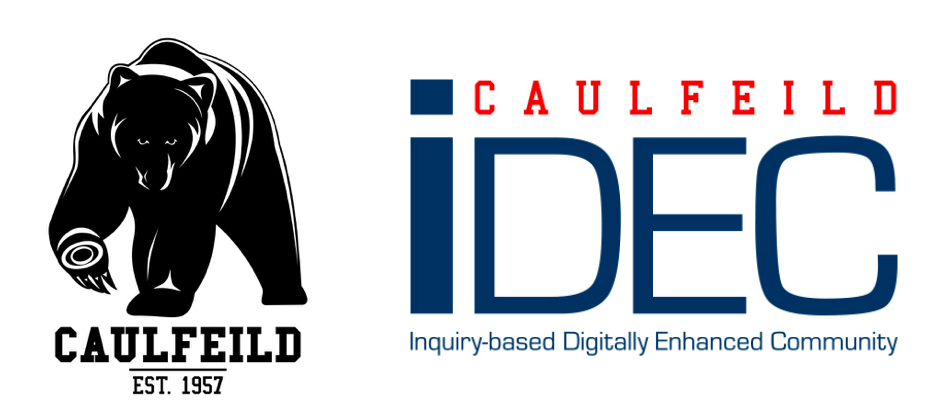

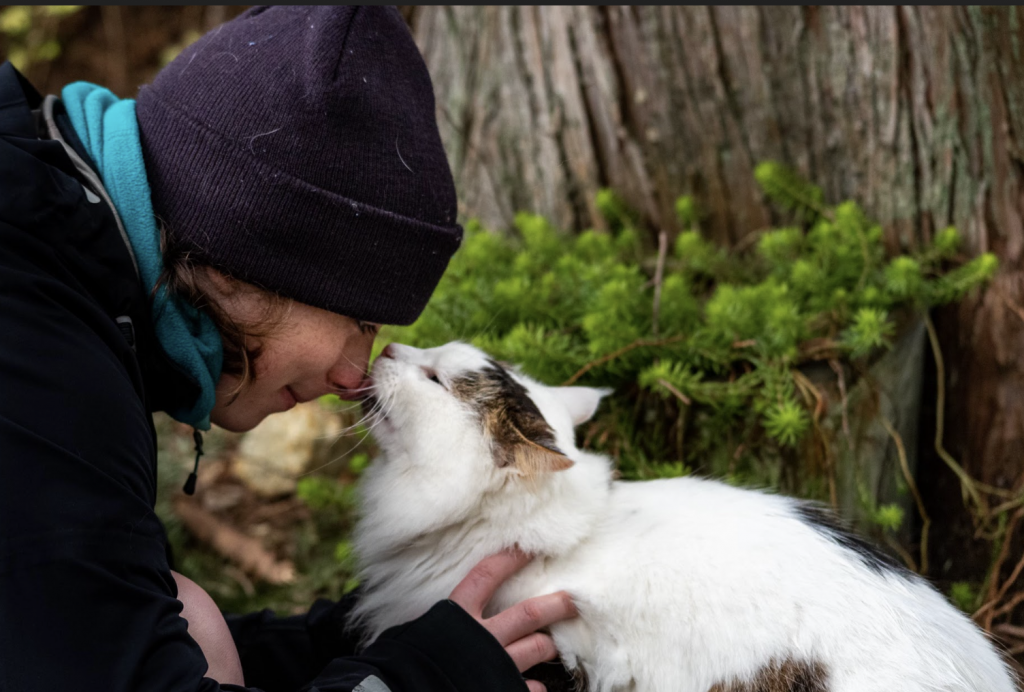
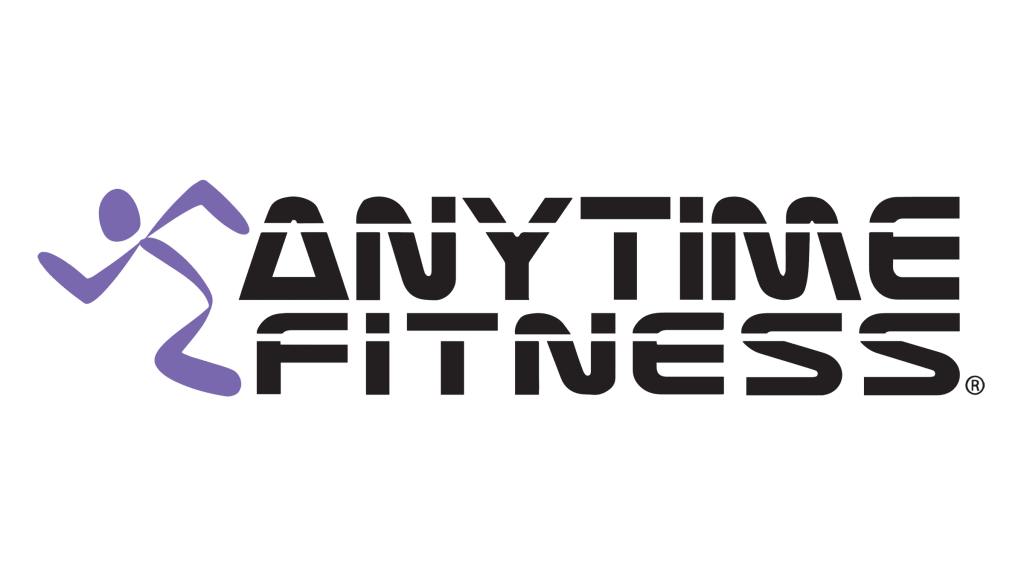
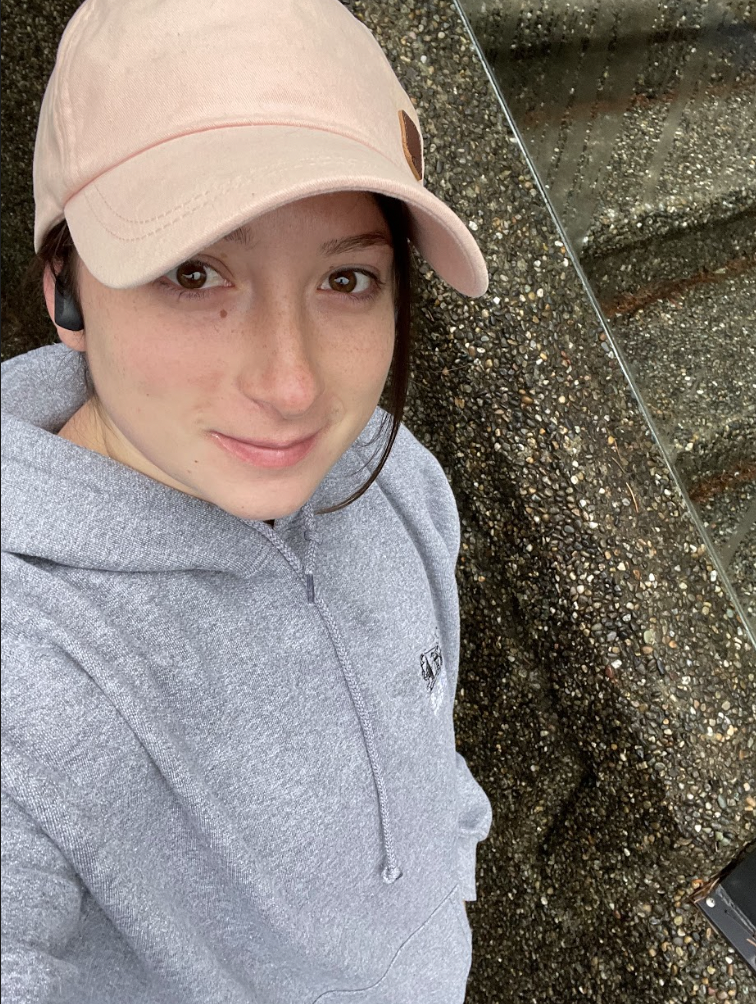
Hi Junel!
Your “World’s Best Teacher” bag is the cutest!
I love that you keep a parking receipt from one of your happiest days in your purse. I had something similar — I kept a parking receipt from The Grove (in LA) in my wallet for a couple of years. I also forgot to throw it out at first, and then I got used to seeing it there and liked having it as a reminder of a great day!
Those are incredible photos from your first time kayaking! It looked like such a perfect day to be on the water.
I also really like that you keep the items from your work and personal life in separate bags. I can see how that distinction supports work-life balance. At the same time, you mentioned that you use your school lanyard for your Anytime Fitness key fob, which suggests to me that you are making conscious decisions about how you would like your work and personal life to interact.
Very happy to be in the same course with you again! I’m looking forward to your posts for the other assignments — the tasks for this course look so fun!
Hey Jocelyn!
Nice to “see” you again! Your reflective comment about my Anytime Fitness key fob on my work lanyard is much appreciated. I agree that this might speak to the fact that I am “making conscious decisions about how [I] would like [my] work and personal life to interact”. This is not only observant, but makes sense. I notice this as well when I am running in West Vancouver around my school’s neighbourhood and wearing the school’s sweater. I think I feel a sense of belonging that I am not ashamed of, as well as I want to represent my work place and set an example of our values.
I love that you also used to save something in your wallet. Sometimes loose items have a memorable impact that we don’t want to let go of yet.
Thank you again for your response! Likewise, I cannot wait to read more of your posts and your thoughts on the next tasks ahead!
Regarding Task 7: Mode-Bending
Junel, I think you did an absolutely fantastic job on using multimodality to redesign the same task we did in Task 1 creatively and engagingly!! I love the quiz aspect after hearing your podcast!!
Re Task 12
I really enjoyed your Powtoon Junel! That was a unique way to present the narrative and I enjoyed the sound effects. I like that many of us focused on the same setting for our utopia and dystopia- as I think any utopia is in the eye of the beholder. Your setting was really topical and I liked that you added some further reading for us.